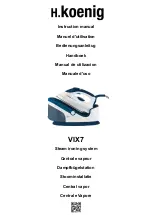
EN
30
Tips
•
Sort the garments to be ironed according to the temperature they can withstand (wool with
wool, cotton with cotton, etc.). Start with garments that have the lowest ironing temperature,
for example, synthetics. Continue with garments that withstand a higher temperature.
•
For mixed materials, e.g. 40% cotton and 60% polyester, use the temperature setting for the
material that withstands the lowest temperature.
•
Use a low temperature for garments with spangles, embroidery, and applications etc.
•
If you are unsure of the temperature the material can withstand, try ironing a concealed part of
the garment. Start with a low temperature and gradually increase to a suitable temperature.
•
Never iron over stains. The heat will cause stains to burn into the material.
•
Use a medium temperature when ironing without steam. A high temperature can leave yellow
marks.
•
Iron silk, woollen and synthetic garments from the reverse side to avoid leaving marks.
•
Iron velvet in the direction of the fibres and do not press on the iron to avoid making the
material shiny.
•
Many fabrics are easier to iron when they are not completely dry for example, silk should also be
ironed when damp.
•
Garments become more wrinkled if the washing machine is full and when spin drying at high
speed.
•
It is important that the soleplate is smooth. Do not run the iron over hard objects, such as
buttons, zips, parts of the ironing board and the like.
•
Fibres of 100% wool can be ironed. Set a large amount of steam and use a dry ironing cloth.
After use
1.
Unplug the iron from the power outlet and drain the water tank.
2.
Wipe the soleplate by plugging in the power cord again and remove it when the status light
goes out.
3.
Let the soleplate cool completely and then wipe it with a cloth dampened with water and a
mild detergent.
4.
Clean the casing with a damp cloth.
5.
Store the iron with the water tank empty, standing on a stable surface with a cloth protecting
the soleplate.



































